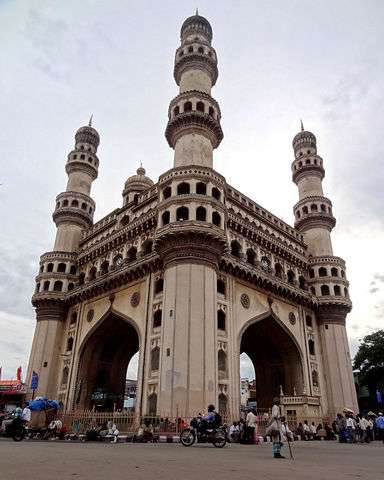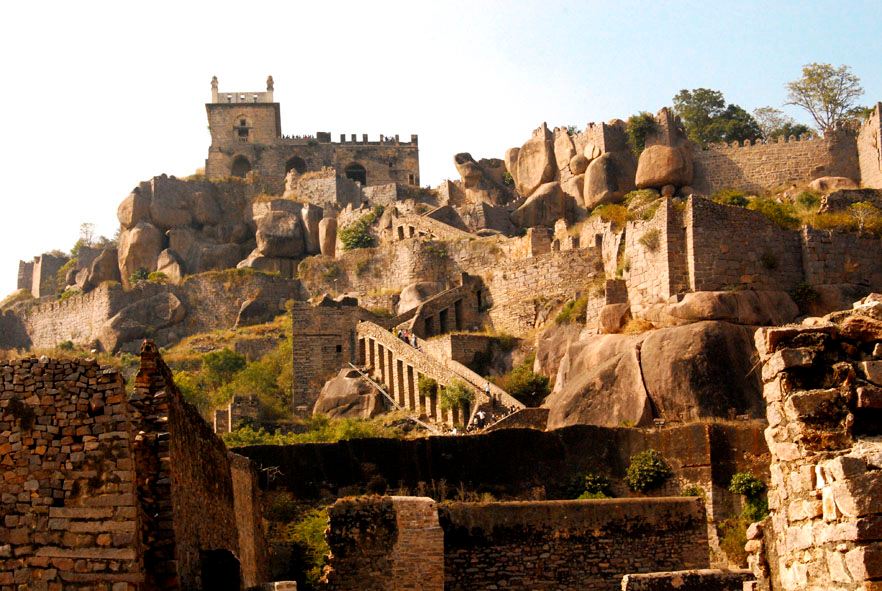
 Telangana State, comprises of 31 Districts and it comes under the Deccan Region, geographically, Hyderabad occupies a pivotal position in the heart of the country. In population, revenue and importance it is one of the leading State in the country which houses 90% of International Offices for their IT & Administration purpose. The population is nearly sixteen million and the annual revenue it earns is around Rs. 26 crores. It covers an area of over 1,14,840 Sq.km with a population of around 3.519 crores. It is high on literacy at 66.46 percent. It has 56.90 Lakhs Hectares of Cultivated Land, 5,03,887 Hectares of Canal Irrigated Land and 3,05,254 Hectares of Lake irrigated land.Over a period of time Telangana was ruled by varied rulers’.
Telangana State, comprises of 31 Districts and it comes under the Deccan Region, geographically, Hyderabad occupies a pivotal position in the heart of the country. In population, revenue and importance it is one of the leading State in the country which houses 90% of International Offices for their IT & Administration purpose. The population is nearly sixteen million and the annual revenue it earns is around Rs. 26 crores. It covers an area of over 1,14,840 Sq.km with a population of around 3.519 crores. It is high on literacy at 66.46 percent. It has 56.90 Lakhs Hectares of Cultivated Land, 5,03,887 Hectares of Canal Irrigated Land and 3,05,254 Hectares of Lake irrigated land.Over a period of time Telangana was ruled by varied rulers’.
The earliest or the first rulers were found to be from the 2nd. Century BC.called the Sathavahans, Salivahanas or the Satakarnis, and ruled for over 400 years. Simukha who founded the Sathavahadynesty united the different Andhra regions into one kighdom between 271 – 248 BC. The sixth ruler of the Sathavahadynesty, Satakarni II was a capable ruler and extended his kingdom more towards the western region in the year 184 BC and ruled for 56 years. His successor Pulumavi I continued in the same caliber and reinforce his kingdom with strength & grandeur and also encouraged literary work. The subsequent successor Gathasaptasati of Hala, who was the 17th. Sathavahana King ruled from Dhamapuri in Karimnagar which was the capital city then.The next Dynesty was the Kakathiyas, ruled by Prataparudra, grandson of Rudramamba who followed his grandmother in 1295 AD and ruled for 28 years and he further extended the western border up to Raichur. He was a great Administrator and developed many reforms. He divided the kingdom into 75 Nayakships, to be developed by Vijayanagara Rayas. After VijayanagaraRayas, started the BahamaniDynesty which was ruled by Mohd Shah III.
When the Bahamani Sultanate became weak, Mohd Shah III’s body guard QuliQutub, who hailed from Hamadan, Persia had started his career as Md. Shah’s bodyguard became the Governor of Telangana, the Eastern province of the Bhamani Kingdom. Under the fragile leadership otBahamani Sultanate, QuliQutub, took the opportunity and form his own QutubshahDynaaty in 1518, and devoted all his time in extending the kingdom. He overtook Berar in the Notth, Rajkonda, Deverkonda, Gahanpura, Kovilakonda & Panagal and captured Bellamkonda, Indrakonda, Khammam, Warangal etc. after defeating Sitapati of Bhogikala. He built the Golkonda Fort.
Kakatiya Kala Thoranam Golkonda Fort
Image : en.wikipedia.org Image : indiaunimagined.com
Eventually Jamsheed his assassinated QuliQutub in 1543.Jamsheed ruled from 1543 to 1550 and then was succeeded by his brother Ibrahim. Ibrahim was a very capable ruler and trade and commerce thrived extremely and Telangana was called the mini Egypt, known for its trade, mart & commerce in the whole world. Merchants from Turkistan, Arabia and Persia used to frequent Telangana and established their trade and eventually turned Telangana into a very attractive and prosperous area. Under his reign, he constructed two Tanks, the Ibrahimpatnam Tank and the HussainsagarTabnk, along with a bridge across the river Musi, which is now known as the Puranapul.Ibrahim was a patron of the Hindus and the Telugu literature; he encouraged many telugu poets like Gangadher Kavi, Panuganti Telanganarya, KandukuriRudra Kavi who prospered under his reign. He was a very benevolent ruler especially among his Hindu subjects. His son QuliQutub Shah succeeded his throne after his demise in 1580.Qutubshah continued his father’s good work and shifted his capital from Golkonda to Hyderabad on the banks of the river Musi and got Jamia Mosque constructed at Charminar. He ruled for 31 years and died in 1611. His nephew Mohd. Qutubshah succeeded his throne and fought against the Moughals to stop their advance towards the Deccan & the South. He was also a scholar and composed many gazals, tarki, bunds & rubaya and was succeeded by his son-in-law in 1667, after he ruled for 51 years.
During Sayyed Ahmed’s reign, the Moughals took over Ahmednagar and continued their march at Golkonda, and Sayyed Ahmed was forced to accept the suzerainty of the Moughal Emperor Shah Jahan and paid 8 Lakhs of rupees as a tribute to the Moughals. In the year 1656, Aurangazeb’s son Mohd. Sultan took over Golkonda and occupied Hyderabad with the help of Mirjumla who conspired with the Mughal Emperor , but unfortunately Aurangazeb was forced to release Hyderabad against a payment of one crore and surrendered Chinnoor with the help of Darashekou and Jahanara from Delhi who intervened and helped to release Hyderabad. Mohd. Sultan married the second daughter of Abdullah. After Abdullah died in 1672, his son-in-law Abul Hassan succeeded him and appointed Madanna as his Prime Minister and his brother Akkanna as his commander in chief. In 1687 Golkonda was attacked again by Aurangazeb which was resisted initially but due to treachery of Sardar Khan who was a high officer in the Army who opened the gate of Golkonda fort, and helped Aurangazeb capture the fort in 1687 and Abul Hassan was taken into captivity and they looted the city in every street and market place where lakhs worth in cash, property, chinaware and costly carpets of aristocracy was available.After capturing the Golkonda, Aurangazeb made Mir Qamruddin Chin Qilich Khan in charge of Golkonda, who in turn traced his ancestry to Abu Bakr the first Khalifa, and founded the State of Hyderabad. Six years after Aurangazem died, Emperor Farruhsiyar made M handed over the same to Mir Qamruddin Chin Qilich Khan the Viceroi of the Deccan with the title of Nizam-Ul-MulkFeroz Jang, who was later given the title of Asaf Jah by the then Emperor Muhammad Shah. This was the beginning of the Asaf Jah dynasty which is known up to this day.
By 1724, Hyderabad was virtually independent of Delhi and Mir Qamruddin Chin Qilich Khan’s successors continued to be loyal to the Moghul Emperor upto 1858 when the British took over the governance of India. Birth of Hyderabad – The future stronghold of TelanganaIn 1799 the Nizam aided the East India Company in the war with Tippu Sultan and after the latter’s defeat and death, the British gave a part of his territories to the Nizam, thus the rule of the Nizams came in full force and when the seventh Nizam succeeded the throne on August 1911, he was given the title of His “Exalted Highness” and by an autographed letter from the king of England and was established with the title of “Faithful Ally of the British Government”Hyderabad enjoyed its own coinage, paper currency and stamps. The Hyderabadi Rupee was the currency in Hyderabad from 1918 to 1959 and was in coexistence with the Indian rupee from 1950. Hyderabad was the only Indian Princely State that was permitted to continue issuing its own notes after joining the Dominion of India in 1948 and the Republic of India in 1950.Unfortunately Hyderabad was treated by the British no differently from other Indian States. The right of intervention in internal affairs was repeatedly asserted and exercised. The British Viceroy pointed out that the British Government had the right to intervene in the internal affairs of Indian States, and that the Nizamwas no different from that of rulers of the other Indian states.In March 1946 when all the other Princely states were advised to merge with the formation of Independent India, Nizam of Hyderabad was under the influence of a fanatical body called Ittehadul Musulmin under KasimRazvi, who declared his intention to remain as an independent state.Nizam in turn wanted to use the good offices of the United Nations to remain independent, but the Government of India refused to encourage that, stating that it was an internal Indo – Hyderabad dispute and a domestic one.
Thus started the Razakar Movement under the influence of KasimRazvi, who resisted the integration of Hyderabad State into the Government of India, they inturn also attempted to force Nizam to conform the Hyderabad Princely State to Pakistan as they were affiliated to the Majllis –e – IttehadulMuslimeen Political Party. The Razakar militia viciously defeated all the rebellion put up by the Communists and the Peasantry and committed dreadfulmayhems on the Hindu population and even eradicated patriotic Hyderabadi Muslims such as Shoebullah Khan who advocated merger with India. Countless Hindu women became victims of rape and kidnapping by Razakars. Thousands went to jail and braved the cruelties perpetuated by the oppressive administration. Due to the activities of the Razakars, thousands of Hindus had to flee from the state and took shelter in various camps and the Indian National Congress was not allowed to operate and the party leaders had to seek solace in Vijayawada or Bombay. To counter the Razakars, people of Telangana under the leadership of Swami Ramanand Tirtha formed the Andhra Hindu Mahasabhaand sought integration of the state with the rest of India.Other Parties also became active in defending the general population of Hyderabad from the Muslim Razakar Militia.In 1953, the Indian States Reorganisation Commission was appointed to prepare for the creation of states on linguistic line and the then Home Minister Pandit Govind Ballabh Pant decided to merge Andhra and Telangana to form the State of Andhra Pradesh on 1 November 1956 after providing safeguards to Telangana in the form of a Gentleman’s Agreement.
Read more













